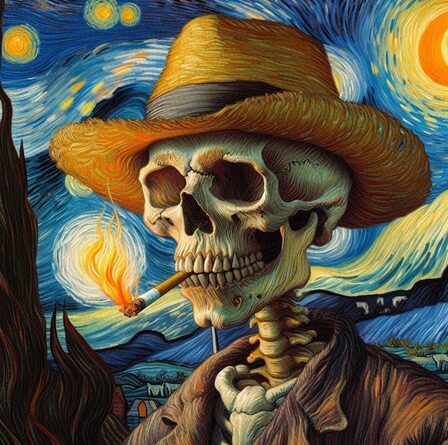Skull Of A Skeleton With Burning Cigarette Is A Smokin’ Creepy Painting By Van Gogh
“Dad, I learned about an artist at school today,” my daughter announced solemnly a few days ago. Of course, I was interested in who that artist was, and it’s hard to say that her answer surprised me. “I don’t remember his name, but he accidentally cut off his ear. He painted flowers,” she replied. I immediately understood who it was, of course, but I thought to myself how I would broach the subject with her because we know that the story of Van Gogh is a real horror movie. Mental insanity, loneliness, ear amputation, and an unclear death are not themes suitable for 7-year-old girls. I also knew that Van Gogh had some dark, even scary, paintings, but I decided to play it safe and ignore anything controversial in his works and probably in his life story. “Yes, flowers are very, very beautiful. Especially yellow sunflowers.”
“Skull of a Skeleton with Burning Cigarette” (from Dutch: “Kop van een skelet met brandende sigaret”) remained outside the professional review I made for my daughter for a few minutes. First of all, it’s hard to say that this is one of the most famous paintings by the Dutch painter, who is responsible, among other things, for the sunflower series and masterpieces such as “Starry Night” (1889), “The Potato Eaters” (1885), “Café Terrace at Night” (1888), and many self-portraits.
Still, we are here on a site that deals with horror. Therefore, a painting from the beginning of the artist’s career can be included in our reviews, mainly because it is visually quite scary and has some fascinating possible meanings.
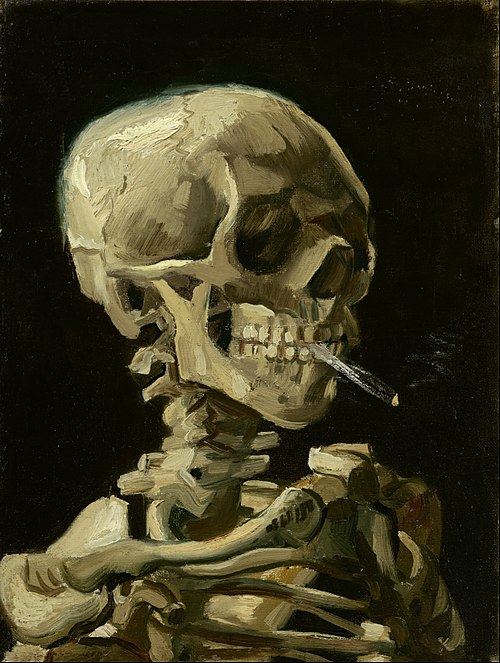
When Was Skull Of A Skeleton With Burning Cigarette Made?
Skull of a Skeleton with Burning Cigarette is a painting created by Van Gogh, using the technique of oil paints on canvas, probably between 1885 and 1886 – that is, it is a relatively early work in his active period. The painting, measuring 24.5X32 cm, depicts – you guessed it – a skull (or actually, the upper part of a Skeleton) with a burning cigarette in his mouth.
Van Gogh created the painting during his stay in Belgium, along with three other paintings featuring a skeleton (e.g., “Hanging Skeleton and Cat”), and it may refer to different thematic and visual styles.
The first style you can see here is the Vanitas style (from Latin, you can translate “Vanitas” as “Meaningless”), which combines symbolic still life paintings intending to symbolize the fact that life is temporary, but death is inevitable. Vanitas paintings, which developed among Dutch and Flemish artists in the 16th and 17th centuries, mainly depicted symbolic items with these meanings, such as skulls, skeletons, hourglasses, candles, rotten fruit, wilted flowers, and other symbols indicating impending death. In some cases, the paintings included a religious interpretation, for example, regarding the eternity after death, in a way that contrasted or complemented the nothingness of life.
Another relevant term here is Memento Mori, which in Latin means “remember (that you have) to die,” which includes the Vanitas and other genres. Works with this artistic symbol or trope remind a person that they will eventually die, even if it is convenient for us to forget or repress this fact. The memento mori genre was familiar in works of art, especially from the Renaissance period. It has expressions in many later works of art and cultural texts: from a short story by Jonathan Nolan, based on which his brother Christopher created the masterpiece “Memento,” through episode titles in series such as “The X Files” or “Stargate SG-1”.
If we claim that Van Gogh chose to deal with death here, we can argue that he may have been significantly influenced by his life story. His father, Theodore, died a few months earlier, and Van Gogh’s health these days was far from perfect, to say the least.
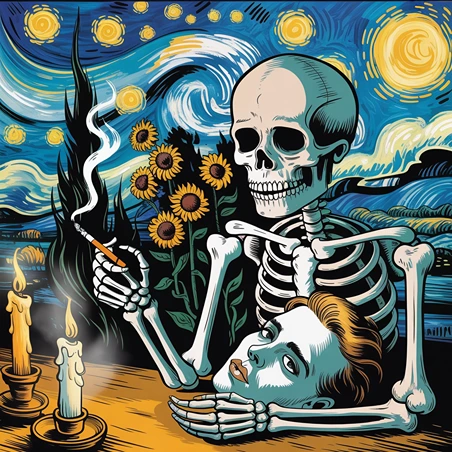
💀 Killer Deals & Scary Recommendations 💀
🎭 Costumes & Accessories
HalloweenCostumes Fun Costumes Entertainment Earth
🛒 Online Shopping
AliExpress Amazon Walmart Etsy
🧛 Collectibles & Horror Brands
Funko Hot Topic Lego Spirit Halloween
🎢 Attractions & Tours
GetYourGuide Tiqets Viator Klook
📖 Blogs & Horror Sites
Bloody Disgusting iHorror Fangoria
🩸 Disclaimer: Some links are affiliate links. The price stays the same – it just helps keep the site alive 👻
Why Did Van Gogh Paint Skull Of A Skeleton With Burning Cigarette?
One of the main questions about any work, indeed by an artist of Van Gogh’s stature, is what the poet wanted to say, or more precisely, the painter wanted to paint.
Naturally, one might think that the Skull of a Skeleton with Burning Cigarette is a kind of anti-smoking campaign, which could easily star as a campaign by medicine and government institutions worldwide. After all, we see here a skeleton – that is, a dead person – with a lit cigarette in his mouth. If you think about it for a while, you can argue that smoking is a danger to life, etc., etc., as you can see in several anti-smoking campaigns around the world that have this basic idea.
The painting got back to life in 2008 when book cover designer Chip Kidd illustrated it on the cover of the successful book “” by American author and humorist David Sedaris, who first came to prominence when he described his life as an employee disguised as Santa Claus’s helper for two years at Macy’s. “When You Are Engulfed in Flames” is based on “eclectic stories” about essential topics such as making coffee when the water isn’t running, a candy bar falling from his mouth into the lap of another passenger on a plane, covering windows to protect “neurotic songbirds,” and of course, a significant reference to the author’s attempt to quit smoking, which in this case involved a trip to Japan and the waste of tens of thousands of dollars. Sedaris saw Van Gogh’s work on a tourist postcard in Amsterdam, was enthusiastic, and decided to incorporate it into the book.
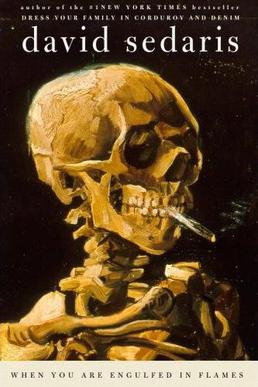
Preaching against smoking is probably not the direction here if we want to discuss the Skull of a Skeleton With Burning Cigarette Meaning. Van Gogh himself was a heavy smoker (and probably also a considerable drinker). In those years, awareness of the harms of smoking – and especially its connection to lung cancer – was low, if at all. The X-ray technique that the painting may remind us of, at least when viewed in the 21st century, was also invented only a few years later, in 1895, by German physicist Wilhelm Conrad Röntgen.
Despite the ideological affiliation with the genres mentioned above, especially in the question of death, it is possible that Van Gogh’s direction was completely different. The accepted opinion today is that Van Gogh used this painting to mock the conservative approach of the Academy to art. Van Gogh, who was part of the Academy at various times in his life (during those years, he studied at the Royal Academy of Fine Arts in Antwerp, Belgium), was negatively impressed by it. He lived at the time in Antwerp, where he moved after being forced to leave his native village following a local scandal: Van Gogh got one of his photo models pregnant and became a target of criticism in the community, partly due to the influence of religious factors. Van Gogh was accused of forcing his “paintbrush” on her, and the village priest forbade women from modeling for men.
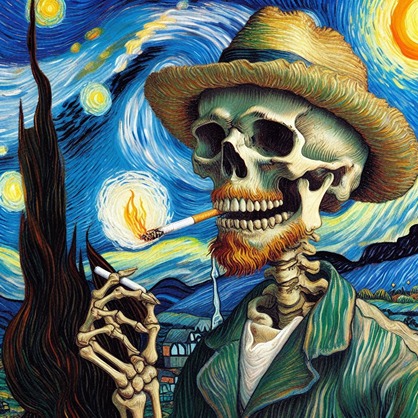
In Antwerp, Van Gogh lived in a small apartment above a paint dealer’s shop. His brother Theo sent him small stipends of money, which Vincent used for art supplies and a modest lifestyle that mainly included massive drinking of coffee (and probably alcohol), bread, and tobacco. This lifestyle further deteriorated the painter’s already precarious health, but even under these conditions, he did not give up on his art.
Skull of a Skeleton with Burning Cigarette reflects that painters at the time were learning about anatomy through skeletons rather than flesh-and-blood models. According to the Van Gogh Museum website, a museum in Amsterdam that houses many famous artists’ works, the painting was mostly a “juvenile joke.” Van Gogh was responding here to the fact that drawing skeletons was a common exercise in academia. Van Gogh, who was very bored in the classes and saw them as useless, actually came out here against the fact that although drawing skeletons was an essential part of the art and anatomy studies that were part of them, no one had also tried to draw them in color and in a more thoughtful way. As it seems, Van Gogh painted the work in between classes or at another time and not at the school desk itself.
How scary Is The Painting?
As a fan of horror and Gothic elements, Skull of a Skeleton with Burning Cigarette attracted the writer of these lines from the first moment he saw it by chance. But there is more here than a drawing of a smoking skeleton. On the one hand, the painting is creepy, but on the other hand, it includes a particular kind of humor, even macabre.
Van Gogh conveys different emotions here, creating an image that sometimes seems rebellious, even boyish: A painting of a dead element that surprisingly came to life with the help of an object that today is more associated with death. The feeling is that the painting looks into our body and creates an image of a body that may be alive but is already almost rotten to the bone.
The importance of the painting may also stem from the fact that it is very different from the catalog of works by the Dutch artist. The style and subject matter differ from what we are used to seeing, and the combination of humor and darkness is not evident in all of his works. If we are used to seeing Van Gogh’s colorful works, with complex brushstroke techniques and several layers of paint, in this case, the work is almost monochromatic. The skeleton is highlighted even more on the black background, with the figure expressing mainly shape and shadow, with a small amount of brushstrokes. Incidentally, some see the painting as a self-reflection by Van Gogh, or at least a work that gives us a specific idea of his personality and feelings about himself.
With all these analyses, this is still one of Van Gogh’s more mysterious works. The following video from the excellent Inspiraggio channel, under the catchy title “The Van Gogh Painting No One Fully Understands,” presents the main points of this mystery. To this day, we do not know whether this is really a joke criticizing the Academy, as claimed on the museum’s official website, or whether Van Gogh may have presented “Vanitas” here, partly due to the tragedies he experienced in his life and his problematic health condition that made him think even more about human existence, the meaning of life and the certainty of death, which had already begun to knock on his door.
Where Is The Skull Of A Skeleton With Burning Cigarette Today?
Like other paintings by Van Gogh, Skull of a Skeleton with Burning Cigarette has also changed hands quite a few times over the years, usually following death, to the point that some would argue that it is a cursed painting in the complete sense of the word, similar to some of our other works in our scary paintings section.
Initially, Vincent’s brother, Theo, known to be the person closest to him, owned the painting. Theo suffered from a degenerative infectious disease of the central nervous system, and his mental state and health deteriorated significantly after Vincent died in 1890. At some stage, he was hospitalized too in a psychiatric hospital and died there at the age of only 33, about six months after his brother’s death. After his death, the painting was passed to his widow, Johanna van Gogh-Bonger, who owned it for several decades until she also passed away in 1925, at 62, after years of battling Parkinson’s disease.
The painting’s next stop was Theo and Johanna’s son, who inherited the painting. Because the painting was in the possession of the Van Gogh family, it is hard to say how much Skull of a Skeleton With Burning Cigarette is worth, and many consider it priceless.
It was not until 1962 that the Van Gogh Foundation purchased the painting and lent it to the Stedelijk Museum of Modern Art in Amsterdam for almost a decade. Its next stop in 1994 was the Van Gogh Museum, located right next door, on the Museum Square in the Dutch capital, where it remains to this day.
It is important to note that the painting occasionally travels around the world. Over the years, it has appeared in various museums and galleries in cities such as Paris, Vienna, Helsinki, Los Angeles, Washington, Tokyo, and Berlin. Starting in February and continuing until the current period (June 2025), you will find the painting in the exhibition “Gothic Modern. From Darkness to Light” at the National Museum in Oslo, Norway.

